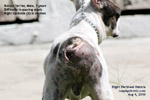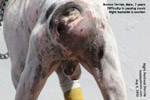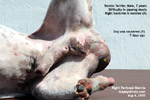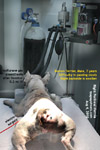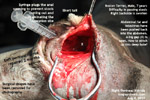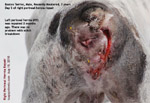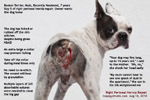"The backside lump keeps getting bigger," the young man and caregiver of the Boston Terrier phoned me in the first week of August 2010. "My dog can't poop normally. You need to operate on him."
I had repaired the left perineal hernia in a Boston Terrier in Jun 2010. The surgical outcome was excellent and I was glad. Surgeries take a long time and can result in complications.
 |
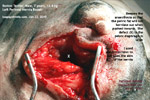 |
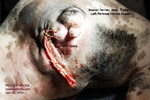 |
|
Left perineal
hernia in a
Boston Terrier
has been
repaired in
June 2010 |
||
"The swelling is the
rectum full of
stools. Part of the
rectum had dropped
into this perineal
hernia and you can
see it as a lump. It
is therefore hard
for the dog to pass
motion. Use your
finger to push the
lump back into the
abdomen so that he
can poop and make an
appointment for
surgery," I had just
neutered this dog 7
days ago. Neutering
is reported to
reduce the incidence
of perineal hernias
in the male dog. It
was better late than
never.
ANAESTHESIA
The owner is worried
that his old dog may
not survive a 3rd
anaesthesia. The
first two were for
the repair of the
left perineal hernia
in June 2010 and
neutering. Many dog
owners in Singapore
are aware of the
risk of the dog
dying on the
operating table and
the internet forums
of such cases
frighten them. In
this dog, the only
cure was to operate
to close the big
hole inside the
right perineum as
the dog had great
difficulty and pain
in pooping.
Domitor 0.2 ml IV
and isoflurane gas.
An I/V saline drip.
No problem. I did
not use Antisedan to
wake up the dog as
he would wake up
naturally.
SURGERY
The hole was even
larger than the left
perineal hernia I
did in June 2010. My
assistant Mr Saw
wore a glove and
asked me: "Do you
want me to dig out
the stools?" I said:
"It is better not to
do it. The dog's
rectum may be
traumatised. In any
case, it is not
necessary to empty
the stools from the
rectum." I was never
more mistaken.
Under anaesthesia,
the solid stools
started to pop out
of the anus. My
assistant removed
them with a tissue
paper. I had not
plugged the anal
opening with the
syringe or
something.
I used
electro-incision to
open a big curved
incision of the
skin. Fatty mass
spilled out of the
wound. I used the
retractor to open
widely and
horizontally the
herniated muscles.
I could not believe
it. The whole defect
was over 4 cm x 6 cm
in diameter and very
deep. As deep as 3
cm. There was not
much muscle layer to
stitch from the
right lateral side
to the anal
sphincter. Would the
stitches hold? There
would be no second
chances.
In this case, I
could see the
reddish right
ventral wall of the
rectum. I placed
several layers of
2/0 absorbable
stitches to close
the gap. "The
retractor is very
useful," Mr Saw
remarked. "Yes," I
said. "It opens up
the hole so that I
can stitch up
properly."
The whole area was a
mess. I could see
one big vein but not
the nerve which was
supposed to be
present in theory.
POST-OP CARE
In theory, the dog
should be crated for
14 days and given
limited movements
for another 14 days
so that the stitches
would not break
down. To save money,
the owner would take
the dog home in 4
days and confine the
dog himself.
CONCLUSION
Sometimes it is
better to neuter the
dog when he is
young. For the past
years, I have had
not seen a case of
perineal hernia in
neutered dogs. The
incidence in
neutered and female
dogs is very low. In
just the past 2
months, I have had
operated on 2 male
not neutered dogs
with perineal
hernias.
One of the recent
cases of a right
perineal hernia in
an 8-year-old Shih
Tzu is at:
http://www.asiahomes.com/singaporetpvet/0514haematoma_perineal.htm
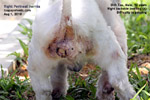 |
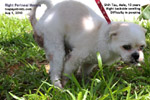 |
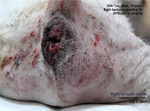 |
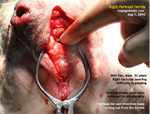 |
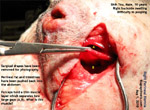 |
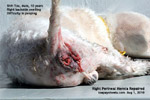 |
| Right perineal hernia in an 8-year-old non-neutered Shih Tzu. The hernia was discovered by the teenaged girl "recently". The complaint was "constipation" | ||
Perineal hernias are not common conditions in the sense that I don't see them every week. But they are commonly present in non-neutered dogs. When you see a swelling to the right or left of the anus, get your vet to quickly repair the perineal hernia rather than wait for a long time as it is extremely difficult to stitch up a big gap in the pelvic diaphragm compared to a small one.
 TOA
PAYOH VETS
TOA
PAYOH VETS
